Heatstroke is a serious health concern in Japan, especially during the sweltering summer months. With rising temperatures and increasing humidity, understanding the dangers of heatstroke and learning heatstroke prevention has become crucial.
Table of Contents
- Understanding Heatstroke, How Does Heatstroke Happen?
- Heatstroke in Japan is a Serious Public Concern
- Biggest Causes of Heatstroke in Japan
- Japan Heatstroke Statistics (2023)
- When are the hottest months?
- Who is most at risk?
- How serious were their conditions?
- Where does heatstroke occur most often?
- Traditional Japanese Heatstroke Prevention Methods
- Practical Modern Heatstroke Prevention Methods
Understanding Heatstroke, How Does Heatstroke Happen?

Heatstroke occurs when the body is unable to regulate internal temperatures leading to overheating. This can result in internal body temperature rising to dangerous levels potentially causing internal organ damage. Symptoms of heatstroke include:
- Dizziness
- Headache
- Nausea
- Rapid Heartbeat
- Confusion
- Loss of Consciousness (fainting)
Without prompt treatment, heatstroke can be fatal, making awareness, early intervention and prevention essential.
Writer's Pick
Heatstroke in Japan is a Serious Public Concern

Heatstroke is called 熱中症 (Necchushou) in Japan. It is a serious health concern, especially during summer months when heat is highest and reaches dangerous levels. With rising temperatures and increasing humidity, it is important that people living and visiting Japan understand the potential health risks and dangers that come with heatstroke.
Biggest Causes of Heatstroke in Japan
There are several factors that contribute to Japan’s high number of heatstroke incidences.
- Natural Climate: Japan’s summer months are characterized by high temperatures and humidity, creating an environment that makes it difficult to maintain regular body temperatures.
- Urbanisation: Urban cities like Tokyo and Osaka experience “urban heat island” effect, where concrete and asphalt retain heat, which increases the already high temperatures.
- Lifestyle: Urban areas in Japan are highly reliant on public transportation. As such, people in these areas often need to walk to the nearest public transportation for access, and the distance may be significant. Walking under the hot sun in summer, for extended periods, increases the risk of heatstroke.
- Ageing Population: Victims of heatstroke are usually the elderly who are more susceptible due to age-related changes in the body and existing health conditions that make body temperature regulation less efficient. The lifestyle of public transportation reliance does not hellp.
- Work Atmosphere: Particular job sectors that require workers to work outdoors or in high temperatures are at higher risks of heatstroke, more on this below.
- Public Awareness: Recently, the Japanese government has taken steps to improve public awareness about heatstroke. However, there are still people that are unaware or do not concern themselves with the risks of heatstroke. One of the most common heatstroke problems is “indoor heatstroke”.
- Indoor Heatstroke: Indoor heatstroke is heatstroke while indoors. It is a common cause of heatstroke as people assume simply staying indoors is sufficient as a prevention measure. If the indoor temperature is high, it may be just as bad or worse as being outdoors.
Japan Heatstroke Statistics (2023)

How fatal can heatstroke be? In recent years, Japan has seen a significant number of heatstroke cases due to the higher than normal temperatures.
According to the Ministry of Internal Affairs and Communications’ “Emergency Transport Situations due to Heatstroke from May to September 2023” report, a significant number of 91,467 people were transported to the hospital for heatstroke. In comparison to the same period in 2022, there were 20,438 more people. In 2022, there were 71,029 people transported to the hospital for heatstroke.
Since 2008, when reporting first started, this is the second highest number of people transported for heatstroke. The highest number recorded was 95,137 people in 2018.
What months have the highest risk of heatstroke?
The months of July and August were when the most people were transported.
|
Month → |
May |
June |
July |
August |
September |
TOTAL |
|---|---|---|---|---|---|---|
|
2023 |
3,655 |
7,235 |
36,549 |
34,835 |
9,193 |
91,467 |
|
2022 |
2,668 |
15,969 |
27,209 |
20,252 |
4,931 |
71,029 |
|
2021 |
1,626 |
4,945 |
21,372 |
17,579 |
2,355 |
47,877 |
|
2020 |
0 |
6,336 |
8,388 |
443,060 |
7,085 |
64,869 |
|
2019 |
4,448 |
4,151 |
16,431 |
36,755 |
9,532 |
71,317 |
|
2018 |
2,427 |
5,269 |
54,220 |
30,410 |
2,811 |
95,137 |
Who is most susceptible to heatstroke?
The elderly, aged 65 and above, are most susceptible to heatstroke.
|
Age → |
~28 days |
28 days ~ 6 |
6~18 |
18~64 |
65~ |
TOTAL |
|---|---|---|---|---|---|---|
|
2023 |
5 |
796 |
9,583 |
30,910 |
50,173 |
91,467 |
|
2022 |
2 |
566 |
7,646 |
24,100 |
38,725 |
71,029 |
|
2021 |
7 |
359 |
4,610 |
15,959 |
26,942 |
47,877 |
|
2020 |
3 |
329 |
5,253 |
21,756 |
37,528 |
64,869 |
|
2019 |
1 |
634 |
8,707 |
24,884 |
37,091 |
71,317 |
How serious was their heatstroke condition?
Most patients that have been transported to hospital have mild to moderate symptoms. Patients with mild symptoms do not require hospitalisation; patients with moderate symptoms require hospitalisation; and patients with serious symptoms require hospitalisation for 3 weeks or more. Deceased are those who are pronounced dead upon inspection, and others are those who are transported elsewhere, unable to be diagnosed, or cannot categorise condition.
|
Condition → |
Deceased |
Serious |
Moderate |
Mild |
Others |
TOTAL |
|---|---|---|---|---|---|---|
|
2023 |
107 |
1,889 |
27,545 |
61,456 |
470 |
91,467 |
|
2022 |
80 |
1,633 |
22,586 |
46,411 |
319 |
71,029 |
|
2021 |
80 |
1,143 |
16,463 |
29,758 |
433 |
47,877 |
|
2020 |
112 |
1,783 |
23,662 |
39,037 |
275 |
64,869 |
|
2019 |
126 |
1,889 |
23,701 |
45,285 |
316 |
71,317 |
Where does heatstroke occur most often?
Most people that suffer from heatstroke were transported from residence to the hospital. This can be taken as an indication of how prevalent indoor heastroke is, but may also be that symptoms only appeared after returning home.
|
Location of |
Residence |
Workplace ① |
Workplace ② |
Public Place |
Public Place |
Streets |
Others |
TOTAL |
|---|---|---|---|---|---|---|---|---|
|
2023 |
36,541 |
9,324 |
2,013 |
7,497 |
11,742 |
15,186 |
4,854 |
91,467 |
|
2022 |
28,064 |
8,127 |
1,690 |
5,248 |
8,368 |
11,807 |
3,750 |
71,029 |
|
2021 |
18,882 |
5,369 |
1,421 |
3,172 |
5,298 |
8,378 |
2,953 |
47,877 |
|
2020 |
28,121 |
7,065 |
1,599 |
4,340 |
6,130 |
11,276 |
3,437 |
64,869 |
|
2019 |
27,500 |
7,403 |
1,792 |
6,213 |
8,944 |
11,137 |
3,959 |
71,317 |
※ MIC, “令和5年(5月から9月)の熱中症による救急搬送状況” [2023.10.27] PDF
Below, we will introduce both traditional Japanese and modern practical heatstroke prevention methods to keep cool and safe every summer in Japan.
Traditional Japanese Heatstroke Prevention Methods
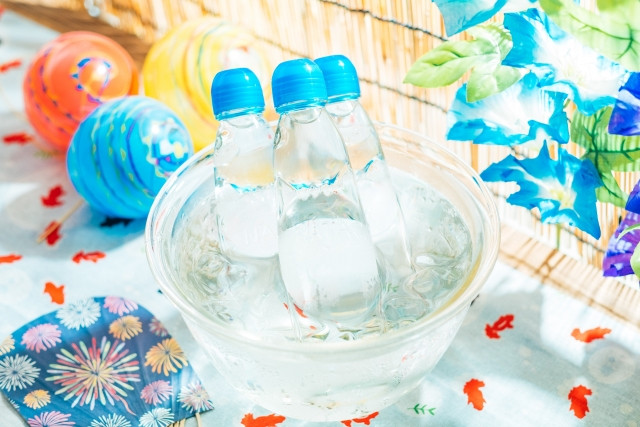
In Japan, people have traditional methods for heatstroke prevention and overcoming the hot humid summer. Apart from physically lowering your body temperature, there are also ways to mentally cool yourself down through senses like sight and sound.
Traditional Japanese Summer Wear

-
Yukata (浴衣) is a summer kimono that is made with thin, light and breathable fabric ideal for muggy summer climates. The open neck and wide hem also allows for air circulation and heat escape.
-
Jinbei (甚平) is indoor clothing for men and young children consisting of short sleeved top and shorts. Nowadays, there are Jinbei for women too, and people wear them outdoors to summer festivals and firework festivals.
-
Accessories like traditional fans Uchiwa (うちわ) and Sensu (扇子) are tools to help you cool down by creating a breeze. There are many designs and colours that evoke “cool” feelings, such as light blue colour and water or wave prints.
Read more about Traditional Japanese Clothing here.
Traditional Japanese Summer Food
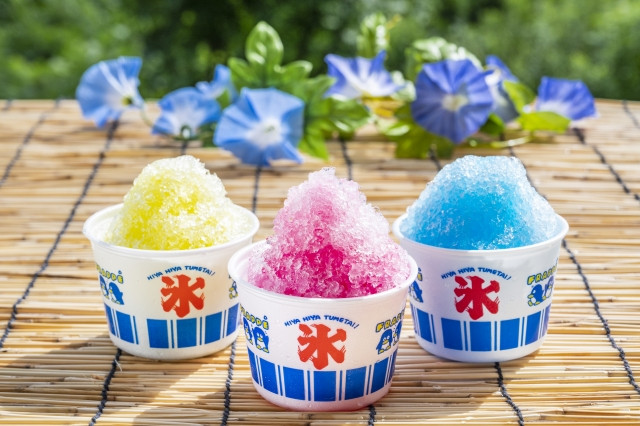
-
Kakigori (かき氷) is Japanese shaved ice. It is a popular summer dessert and snack to cool down. There is classic crushed ice with sweet syrup that is commonly found at summer festivals and fireworks festivals, and also fancy kakigori served with an assortment of toppings available at restaurants, usually for a limited time.
-
Kuzu-mochi (くず餅) and mizu-yokan (水羊羹) are popular summer traditional Japanese sweets. The semi-transparent appearance makes it look cool. Their high water content also makes it light and hydrating.
-
Cold noodles are a staple dish to enjoy in summer. There are various kinds including cold somen, cold soba, cold udon, and cold tsukemen.
Read about 40 Japanese Summer Food to Try in Japan’s Hottest Months here.
Traditional Japanese Wind Chime, Furin Decoration

Furin (風鈴) is a popular Japanese summer decoration. It is a wind chime that is made from glass, metal or ceramic. When the wind blows, the wind chime rings out. The Japanese have long used the wind chimes to associate oneself with the cool breeze of wind. Just by hearing the tinkling sound of the furin, they will feel a sense of coolness as a form of Pavlov response.
Practical Modern Heatstroke Prevention Methods

Traditional Japanese heatstroke prevention methods are certainly effective, but there are other effective “cooling goods” that are more practical to use on a daily basis. Many of these are available to purchase at drug stores, lifestyle good stores, or 100 yen shops.
1. Cool Shirt Spray
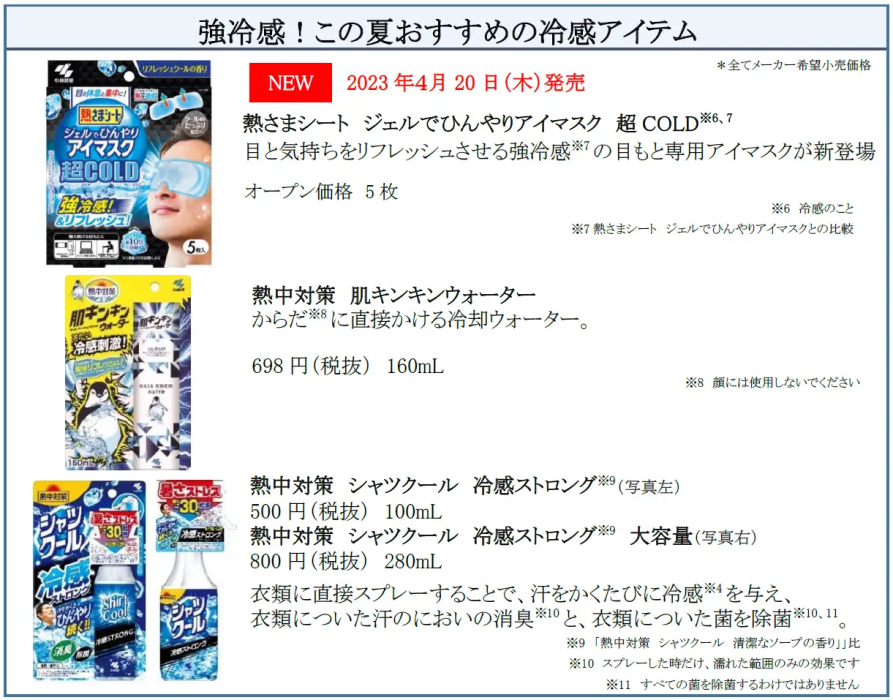
Image from PR Times.【From top, Cold Eye Mask by Kobayashi Pharmaceuticals, Cool Body Water, and Shirt Cool by Necchu Taisaku】
Any type of top, no matter how breathable and light, can feel uncomfortable in the dead of summer. This “cool spray” is applied to your top where it creates an icy feeling for up to 30 minutes or so to cool you down. There are different brands so choose one that you like. You can also get a portable one to re-spray at any time.
Example of “Cool Shirt Spray” available on the market:
- Necchu Taisaku’s Shirt Cool
- Tokiwa’s Shirt Shower
- Ice-Non’s Shirt Mist
- Ice Aroma’s Ice Aroma Mist
2. Cool Wipes and Cool Sheet

Image from PR Times.【Hiya Sheets and Cooling Body Mist by Biore Kao】
Wipe down and refresh with cool wipes and cool sheets, called 冷却シート (Reikyaku Shi-to) or 冷シート (Hiya Shi-to) in Japanese. There are also adhesive types that you can stick on your forehead to feel nice and cool. They can also be used to cool down fevers.
Example of “Cool Wipes” available on the market:
- Biore’s Hiya Sheets
- Gatsby’s Facial Wipes Ice Type
- Ice-non’s Reikyaku Sheets
- Kobayashi Pharmaceuticals Reikyaku Sheets
3. Cool Body Mist and Body Spray
To look for cooling body mist, search for “冷感ボディミスト (Reikan Bodi Misuto)” and they will show up. Cooling body mist works similarly to cool shirt spray introduced above, except that you can apply it directly on your skin. Compared to cool shirt spray, the icy feeling is instantaneous. As you sweat, the coolness intensifies and can last up to 30 minutes, perfect for work travel. They come in an assortment of scents so choose your favourite.
Example of “Cooling Body Mist” available on the market:
- Biore’s Cooling Body Mist
- AROMIC’s Aromic Deo Body Aroma Mist
- House of Rose’s Mintleap Cool Body Spray (part of their cool body and hair care line)
- Gatsby’s Crazy Cool Body Water
- Daily Aroma Japan’s Snow Water (for scalp also)
4. Cool Scalp Spray, UV Scalp Spray, Cooling Dry Shampoo
Another similar product to cool body mist is cool scalp spray that is especially made for the head and scalp. There are products that can be used both for body and head, but unless specified otherwise, you should not use body for scalp due to sensitivity of your scalp. Cool scalp spray is recommended for everyone, but especially for people who wear hats for sun protection to keep your head and hair smelling nice and feeling cool.
There are also scalp sprays specifically for sun protection for your scalp and hair (especially dyed hair). You may also be interested in dry shampoo that contains a cooling effect.
Example of “Cool Scalp Spray” available on the market:
- Ice-Non’s Head Cool Spray
- Gatsby’s Head Freezer
- House of Rose’s Mintleap Cool Scalp Spray (part of their cool body and hair care line)
- Daily Aroma Japan’s Snow Water (for body also)
- Necchu Taisaku’s Ice Dry for Head Use
Our team member recommends preparing yourself to go out with the ultimate combination of “Cool Shirt Spray + Cool Body Mist + Cool Scalp Spray”.
5. Cold Eye Mask
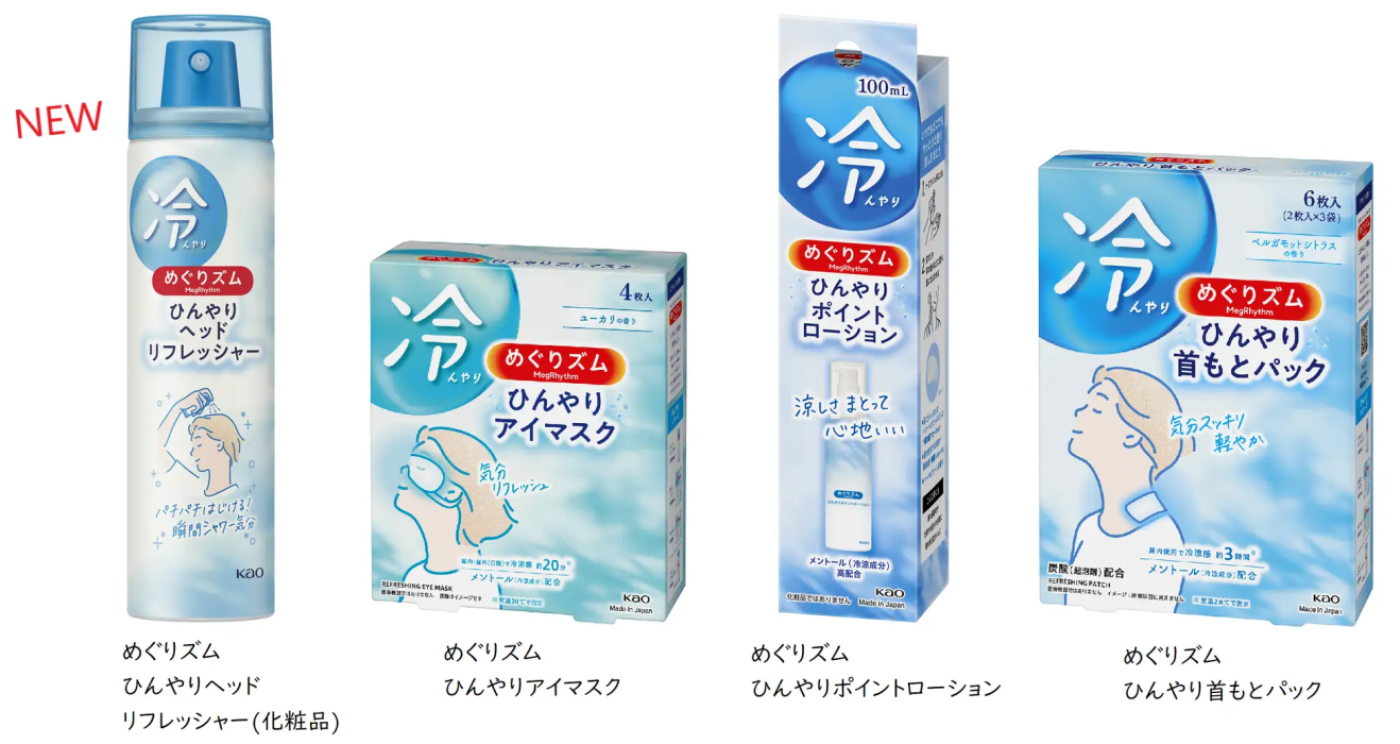
Image from PR Times.【From Left: Cool Head Refresher, Cool Eye Mask, Cool Point Lotion, Cool Neck Pack by Kao】
Hot eye masks are popular in winter, while cold eye masks reign supreme in summer. Keep cool and refreshed with cold eye masks that also work to refresh your eyes. There are many brands, so browse, try and pick your favourite.
Example of “Cold Eye Mask” available on the market:
- Kobayashi Pharmaceautical’s Cold Eye Mask
- Ice-Non’s Quick COOL Eye Mask
- Kao Cooling Eye Mask
6. Handy Fan
Handy fans, called 携帯扇風機 (Keitai Senpuuki), are handy tools during summer. They are easily available and at affordable prices at lifestyle good shops, drug stores, 100 yen shops, and also online. As summer approaches, there are many that go on sale so watch out. Nowadays, there are also handy fans that double as power banks.
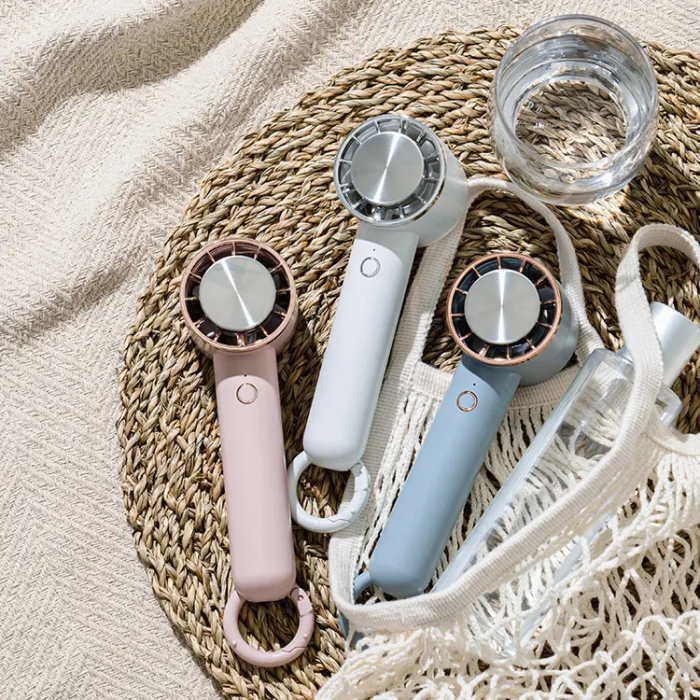
Photo from PR Times.【Peltier Cool Plate Handy Fan with Carabiner by Life on Products】
A recent innovation to handy fans are cooling plates that can produce cool air like an air conditioner. The keyword when searching for these fans is “冷感 (Reikan) + 携帯扇風機 (Keitai Senpuuki)”. You will see from images that the centre of the fan has a metal plate that you can touch to your skin to enjoy the cooling effect. The metal plate can reach temperatures as low as 10°C, you can see the condensation gather on the plate.
7. Parasol
Parasols are called 日傘 (Higasa) in Japanese. Not only are they useful for keeping out of the sun, but they also offer UV protection. As we enter summer and there are more sunny days, you can see many people on the streets carrying parasols. It is an effective heatstroke prevention method especially when paired with other prevention measures.
There are many designs for parasols. Popular and useful characteristics to look for are:
- Lightweight
- Small and compact
- Strong against wind
- High UV protection
- One button push to open and close
8. Ice Ring
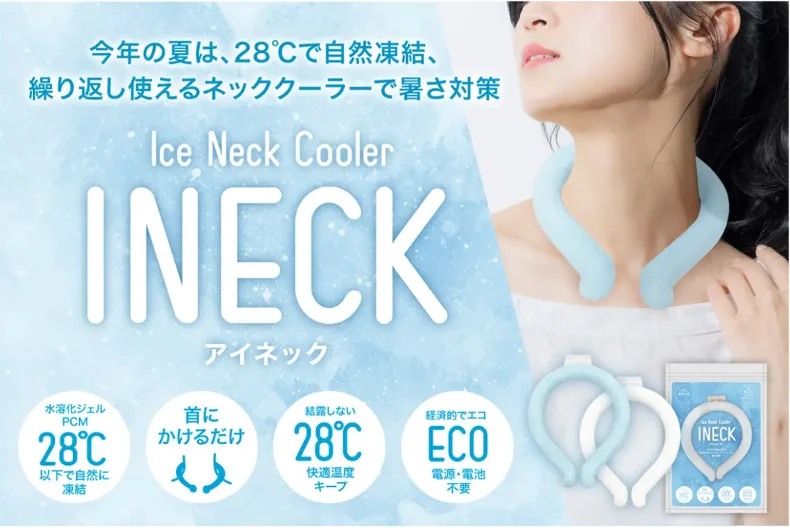
Image from PR Times.【INECK Ice Neck Cooler by IGoods】
Ice Neck Cooler, or Ice Neck Rings, are popular cooling hands free devices that go around your neck, one of the key spots to cool down when hot. It depends on the brand, but most ice rings naturally freeze and stay cool at 28°C. To speed up freezing after it has melted, you can put it in cool water, in the fridge, or in the freeze. One of our readers keeps hers in the freeze at all times, so it is freezing cold and ready to use whenever needed.
Some people say it looks lame, but during the peak of summer, practicality and comfort becomes more important than looks. The icy cold feeling that spreads down from your neck can only be described as pure bliss.
9. Cool Towel
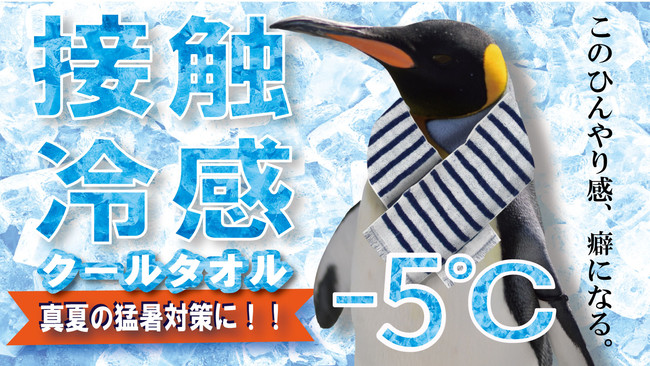
Image from PR Times.【Cool Towel by Jogan】
Cool towels, called クールタオル (Ku-ru Taoru) in Japanese, come in many different forms. It may be in the form of a morning towel, shawl, stole, or scarf. The same material is also used to make arm covers and hats these days. Even in the hottest of summer, the material can remain cool. Wetting the towel will further enhance its effects. Find a pattern you like, and you can also accessorise in summer.
10. Wearable Aircond

Image from PR Times.【WearCool by Gloture】
Wearable air conditioning (着るエアコン、Kiru Eakoon) are also available in Japan to help you beat the summer heat. The above is just one example of them. There are different companies that offer their own designs with unique functionality. They are built to be lightweight and concealable, but the prices are quite expensive, so they are not as commonly used as the other heatstroke prevention measures and “cooling goods”.
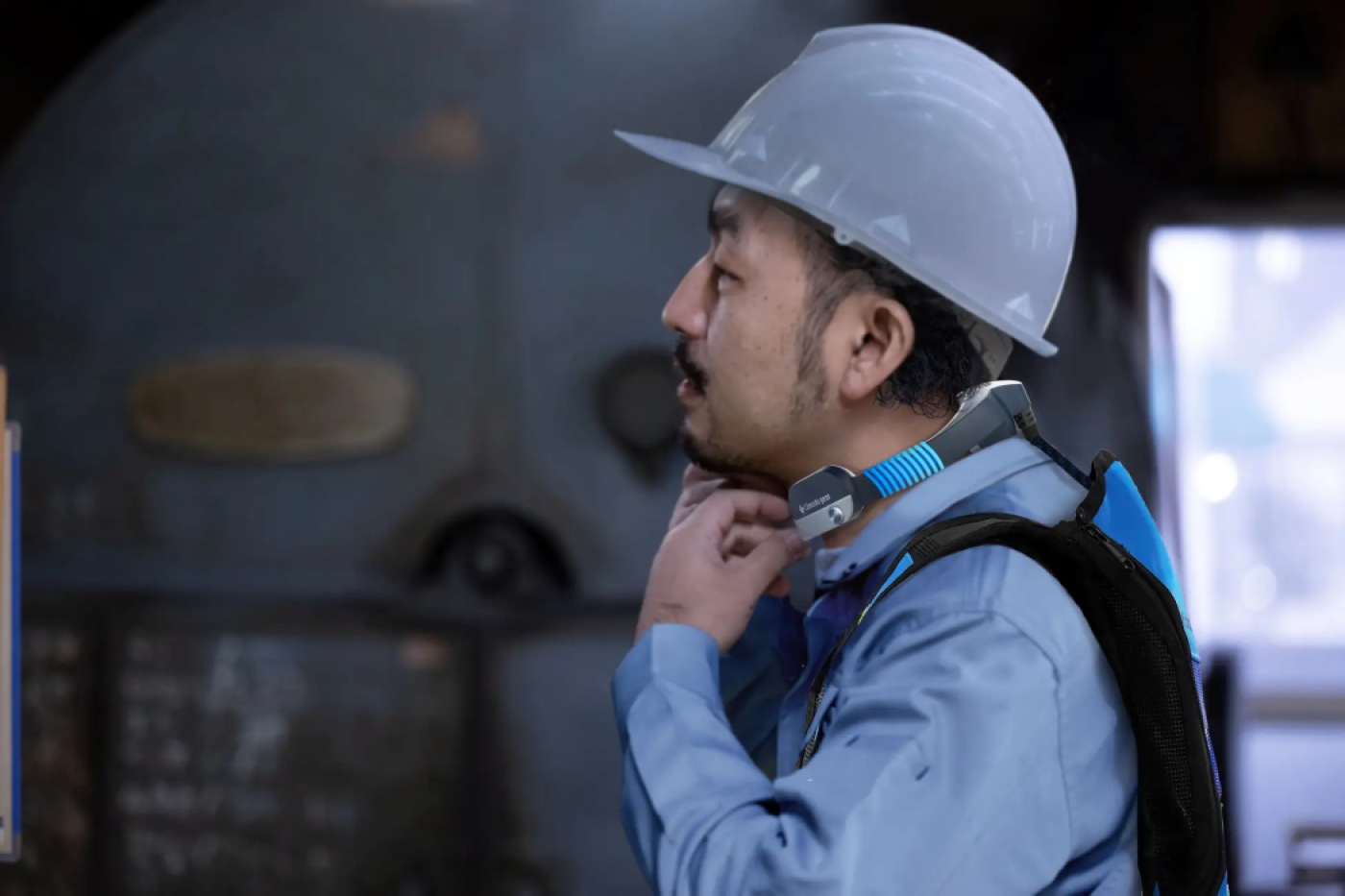
Photo from PR Times. 【Cómodo gear i3 by FUJITSU】
To Close
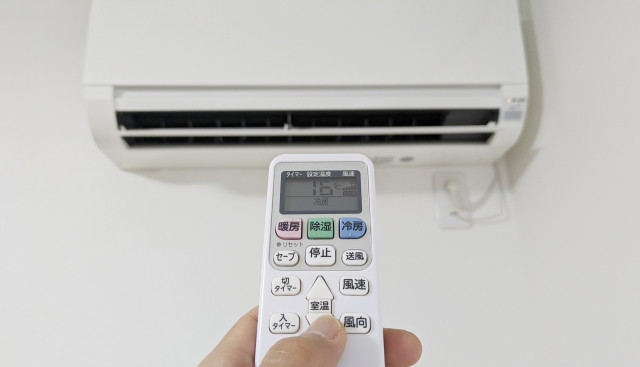
Heatstroke is a serious health concern in countries that experience sweltering summers. During summers in Japan, it is important to check the heatstroke alert warning before going out, but it is also generally recommended to avoid going out during peak heat hours which are from noon to 3pm during the day.
Night time in summers can be just as hot. The Japanese even have a word, 熱帯夜 (Nettaiya), that describes the sultry hot nights. There are many people that end up with heatstroke due to underestimating the heat at night. If it is too hot, switch on the air conditioner. Keep cool and drink plenty of water everyday in summer.




































